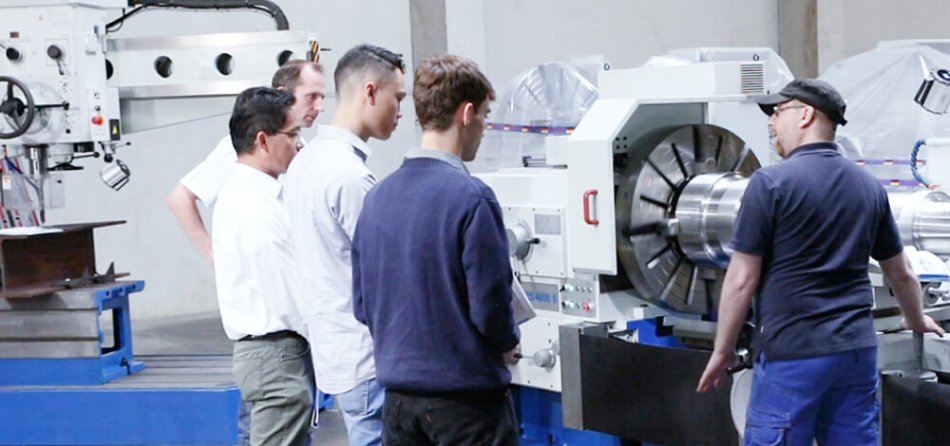How to use a lathe
Using a lathe, also called a turning machine, requires some basic understanding of machine operation and safety precautions. Here are the basic steps on how to use a lathe:
Safety measures: Always wear your personal protective equipment (PPE), consisting of safety glasses, hearing protection, protective clothing and safety shoes.
Preparing the lathe: Clean the machine thoroughly and check that all parts are tight. Check whether there are any loose parts, such as wrenches, in the machine's chuck and remove them.
Setting up the workpiece: Clamp the workpiece securely and align it centrally to avoid imbalance.
Selecting and assembling the tool: Select the appropriate cutting tool for your material and mount it in the tool holder.
Lathe adjustment: Adjust the speed and feed according to the material and machining requirements.
Start the turning process: Perform a test run before starting machining. Monitor the process continuously.
Post-processing: Check the workpiece for accuracy, remove it and clean the work area. Before leaving the machine, switch it off and secure it against accidental restart.
Important notes: Do not overload the machine and react immediately to any problems that may arise during processing. Always follow the manufacturer's operating instructions.
How do I choose the right lathe for my needs?
Regardless of whether you are looking for a lathe for private or professional purposes, there are some important criteria you should consider when purchasing:
Material and weight of the workpiece: When buying a lathe, you should pay particular attention to the performance characteristics, equipment and speeds required for your material. There are special lathes for different materials: lathes for wood and metal lathes for steel, cast iron, non-ferrous metals such as aluminum and brass, as well as for plastics. Choosing the right lathe depends largely on the material to be processed; softer materials require smaller machines, while harder materials such as stainless steel require more powerful models.
Workpiece dimensions: Make sure the lathe's center height and width are appropriate for the size of your workpiece. Center height on lathes refers to the distance between the center of the spindle and the top of the machine bed. This value is important in determining the maximum size of workpiece that can be machined between the centers of the lathe. A larger center height allows for the machining of larger workpieces. Note that accessories such as a centering center can reduce the available space.
Spindle bore: Check the spindle bore, especially if you plan to machine bar stock. The spindle bore on lathes refers to the maximum diameter of the workpiece that can be fed through the machine's spindle. This value is important for determining the size and type of parts to be machined. The larger the spindle bore, the larger the workpieces that can be machined. The bore should be large enough for your workpieces.
Speed and drive power: The speed and drive power required depend on the material and size of the workpiece. Softer materials and smaller workpieces often require less power, while harder materials such as steel require more power.
Electrical requirements: Pay attention to the lathe's voltage requirements. Models can vary between standard voltage and high voltage. Make sure your location supports the electrical requirements.
Space requirements and transport: Consider whether the lathe fits into your work area and can be easily transported there. Take the weight and dimensions of the machine into account, as these often cannot be dismantled. When machining bar stock, make sure that there is enough space next to the spindle passage to fill the machine. In addition, inspection openings and doors, e.g. for the control cabinet, must not be forgotten.
Why should I purchase a lathe from KNUTH?
If you want to purchase a lathe from KNUTH, you can rely on a straightforward ordering process and a fast delivery time. With a wide range of lathes suitable for both industrial applications and smaller workshops, KNUTH offers quality and reliability. You can find more information on the product pages on our website. We will be happy to send you a quote (including price and availability) on request.
Does KNUTH offer customization options?
The KNUTH team will also be happy to advise you in detail to find the perfect lathe for your company. Just call us or write us a message.
Comprehensive customer service for your lathe
Of course, we support you with installation and commissioning and offer training for you and your employees on how to use your new lathe. Technical support and repair service is available for all machine categories in the KNUTH portfolio. Our service staff are your central contact for technical questions. In addition, we work with a network of experienced local service partners. In addition to classic maintenance, we also offer modern remote maintenance services for CNC machines using remote maintenance modules. Thanks to our extensive spare parts warehouse, we can provide most components quickly, even if your machine is already older. This ensures that your machines have a long service life.
Find the Perfect Turning Machine for Your Needs
Looking for high-precision turning machines that deliver top performance? Explore our range of CNC lathes, flat-bed lathes, vertical lathes, and more. Whether you need a compact solution or a heavy-duty lathe, we have the right machine for your workshop. Check out our selection and optimize your machining process today.

























